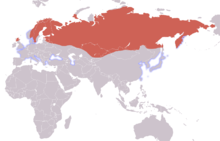Arctic loon
| Black-throated loon | |
|---|---|
 |
|
| Scientific classification | |
| Kingdom: | Animalia |
| Phylum: | Chordata |
| Class: | Aves |
| Order: | Gaviiformes |
| Family: | Gaviidae |
| Genus: | Gavia |
| Species: | G. arctica |
| Binomial name | |
|
Gavia arctica (Linnaeus, 1758) |
|
| Subspecies | |
|
|
 |
|
| Range of G. arctica Breeding range Wintering range | |
The black-throated loon (Gavia arctica) is a migratory aquatic bird found in the northern hemisphere. The species is known as an Arctic loon in North America and the black-throated diver in Eurasia. Its current name is a compromise proposed by the International Ornithological Committee.
The black-throated loon was one of the many species originally described by Linnaeus in his 18th-century work, Systema Naturae. The genus name Gavia comes from the Latin for "sea mew", as used by ancient Roman naturalist Pliny the Elder. The specific arctica is Latin for northern or arctic.
Breeding adults are 58 to 77 cm (23 to 30 in) in length with a 100 to 130 cm (39 to 51 in) wingspan, shaped like a smaller, sleeker version of the great northern diver. Body mass is reportedly from 2–3.4 kg (4.4–7.5 lb). They have a grey head, black throat, white underparts and chequered black-and-white mantle. Non-breeding plumage is drabber with the chin and foreneck white. Its bill is grey or whitish and dagger-shaped. In all plumages, a white flank patch distinguishes this species from all other divers including the otherwise almost identical Pacific diver.
It breeds in Eurasia and occasionally in western Alaska. It winters at sea, as well as on large lakes over a much wider range.
This species can be found to habitate the area around isolated, deep freshwater lakes. It protects this territory. The nest is made on the ground, out of heaped plant material like leaves and sticks on the shores of lakes.
The black-throated loon lays a clutch of two 76 by 47 millimetres (3.0 by 1.9 in) eggs that are brown-green with darker speckles. These eggs are incubated by both parents for a period of 27 to 29 days. The hatched, mobile young are fed by both parents for a period of weeks.
This species, like all divers, is a specialist fish-eater, catching its prey underwater. It flies with neck outstretched. It feeds on fish, insects, crustaceans and amphibians.
...
Wikipedia

